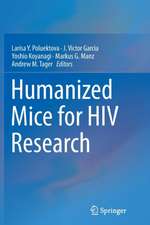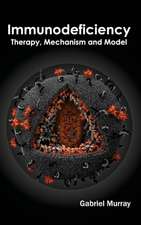Viruses: Intimate Invaders
Autor Van G. Wilsonen Limba Engleză Paperback – 3 mar 2022
Last but not least the book provides exciting insights into how our immune system reacts to different viruses and how vaccines contribute to conquer pandemics. While scientifically informative, this book makes the field of virology understandable to a lay audience and encourages readers to further thinking. And more importantly, it conveys the wonder, beauty, and mystery of these ubiquitous, microscopic marvels.
This book addresses anyone interested in understanding the principles of virology, viral diseases, or the impact of viruses on human societies.
Preț: 156.09 lei
Nou
29.87€ • 31.07$ • 24.66£
Carte disponibilă
Livrare economică 22 martie-05 aprilie
Livrare express 11-15 martie pentru 47.92 lei
Specificații
ISBN-10: 3030854868
Pagini: 290
Ilustrații: XXIV, 341 p. 1 illus.
Dimensiuni: 155 x 235 x 25 mm
Greutate: 0.51 kg
Ediția:1st ed. 2022
Editura: Springer International Publishing
Colecția Springer
Locul publicării:Cham, Switzerland
Cuprins
1. The Question of Life “It’s alive! It’s alive!” – Mel Brook’s Young Frankenstein
An introduction to viruses through some examples that illustrate the size, quantity, and diversity of viruses on earth, followed by a short history of the discovery of viruses. The chapter focuses on the concepts that define life through an examination of animals, plants, and single-cell organisms. These basic features of living organisms are then related to viruses to demonstrate that viruses fail most of the definitions of life and act instead as unique, self-replicating nano-machines.
1.1. Weird Facts and Big Numbers
A playful discussion of the sizes and numbers of viruses in our world
1.2. From Ignorance to Fascination
A brief history of the discovery of viruses
1.3. A Biological Primer – Multicellular Organisms
The biological, functional, and genetic characteristics that define plants and animals
1.4. Smaller, but Still Alive – Unicellular Organisms
The biological, functional, and genetic characteristics that define bacteria and yeast
1.5. Biochemistry – You Can’t Escape It
The important biomolecules needed for all living organisms
1.6. Viruses at Last
A comparison of viruses with living organisms to illustrate the just how different and unique viruses are from any other organisms on Earth
2. Families, Form, and Function
“A virus a piece of bad news wrapped in protein” – Sir Peter Medawar
An overview of viral taxonomy (families); structure, organization, genetics, and reproduction (form); and pathogenic mechanisms (function). This chapter develops the foundational concepts and vocabulary that are expanded on with specific topics in the subsequent chapters.
2.1. Taxonomy and Other Geeky Things
An explanation of how viruses are named and classified
2.2. Virions, the Viral Vehicle
A discussion of the viral particle including its shape, component pieces, and functions
2.3. Alive or Not, Viruses Have a Life Cycle
The steps in the reproduction process that are common to all viruses 2.4. Infection and Disease - How Viruses Spread and do Nasty Things
The mechanisms by which viruses infect cells and cause damage to cells and organs in our bodies
3. Ancient or New – On the Origin of Viruses
“Endless forms most beautiful and most wonderful have been, and are being evolved” - Charles Darwin
An examination of the origins of viruses and their co-evolution with living organisms. Are they the ancient progenitors of all life or are they degenerate offspring that devolved from more complex existing organisms? Competing views on viral origin will be compared and contrasted. The co-evolution of viruses with humans and our hominid ancestors is also explored.
3.1. We Don’t Know Exactly Where We Came From, but We’re Here Anyway
A brief history of the universe and the evolution of life on Earth
3.2. Are Viruses the Chicken or the Egg?
An introduction to viral origin theories; how did they arise and where did they come from? 3.3. Hypotheses, Hypotheses, and More Hypotheses
Examination of the major historical theories for viral origin evolution
3.4. New Data at Last
Use of nucleic acid and protein information to analyze viral origins and familial relationships
3.5. Closer to Home
How did ancient viruses give rise to modern viral families Papillomaviruses and Hominid Evolution – human papillomaviruses (HPVs) as an example of viral co-evolution with humans
4. Of Predators and Prey
“The single biggest threat to man’s continued dominance on the planet is the virus” -Joshua Lederberg, 1958 Nobel Laureate
Examination of selected viral diseases that illustrate mechanisms of viral spread and the 3 types of infection outcomes: acute disease (influenza), chronic infection (hepatitis C), and latent infections (herpes varicella-zoster). These examples demonstrate the complex interplay between hosts (humans) and predators (viruses) and explain why viruses have evolved to be such persistent infectious pathogens for humans.
4.1. Viral Infections – The Good, the Bad, and the Ugly
The principles of how viruses spread, infect cells, and cause disease
4.2. Influenza – More Than Just Bad Air Influenza virus as an example of an acute infection where the virus is completely cleared from the body after recovery
4.3. Hepatitis C – The Great Deceiver
Hepatitis C virus as an example of a chronic infection where active virus can remain permanently in the host
4.4. Herpes Varicella-Zoster Virus – Now You See It and Now You Don’t
A herpes virus as an example of a virus that cause an acute illness but then becomes latent with the ability to reactivate years later
4.5. Polyomaviruses and Anelloviruses – Predators or Passengers?
Examples of viruses that are commonly found in humans but whose disease role is mostly uncertain
5. Immunity, Immunity, Immunity
“If we think of the immune system as a machine, then we are far from even knowing all of its parts” - Bruce Beutler, 2011 Nobel Laureate
Like the real estate adage about the importance of location, location, location, survival from viral infection illustrates the importance of immunity. The 3 types of relevant immunity (intrinsic, innate, and acquired) will be explained in the context of viral infection. This chapter is the corollary to chapter 4 and discusses how viruses have influenced human evolution as we attempted to combat and counteract viral infections.
5.1. The Big Three – Branches of Immunity
An overview of the three branches of immunity and their roles in protection from viruses
5.1.1. Intrinsic Immunity – Always There When We Need It
The biology and mechanism of by which intrinsic immunity protects from viral infection
5.1.2. Innate Immunity – Locked and Loaded
The biology and mechanism of by which innate immunity protects from viral infection
5.1.3. Adaptive Immunity – The Gift That Keeps On Giving
The biology and mechanism of by which adaptive immunity protects from viral infection
6. Viruses That Shaped our World
“A virus can change the fate of the world; power has nothing to do with being tiny or giant!” ― Mehmet Murat Ildan
In addition to the consequences of viral infection for the individual, large scale viral effects on human populations have influenced history and culture. Examples covered will include smallpox, influenza, poliovirus, and HIV, each of which had important sociological effects on human populations.
6.1. Smallpox – Mankind’s First Conquest
The history of smallpox and its devastating Effects on Europe and the New World
6.2. Polio – A Force for Change
The history of polio virus and how outbreaks in 20th century America led to the emergence of disease philanthropy and vaccine development
6.3. HIV/AIDS – A New Pandemic for the 20th Century and Beyond
The origins of AIDS and how this epidemic introduced universal precautions and inspired medical activism
7. Simian-Virus 40 – How an Obscure Monkey Virus Ushered in the Age of Molecular Biology
“The art and science of asking questions is the source of all knowledge.” – Thomas Berger
The extensive poliovirus vaccination programs of the late 1950s and early 1960s lead to the accidental infection of millions of individuals of an unknown virus (SV40) with cancer-causing potential. This mistake sparked a massive research enterprise to understand this virus. Many of the early tools and foundational discoveries of modern molecular biology, as well as the origins of important regulatory compliance policies, derived from this beginning and still echo in our research and society today.
7.1. Viruses, Viruses, and More Viruses
How advances in technology led to the identification of more and more new viruses in the 20th century
7.2. Polio Vaccines and A Stealth Simian Virus
The discovery of a new simian virus called SV40 as a contaminant of the early polio virus vaccines
7.3. To Be or Not To Be – Is SV40 a Human Tumor Virus?
The discovery that SV40 has cancer-causing potential and the continuing debate on its role in human cancers
7.4. The SV40 Revolution
How SV40 became a prominent model for molecular biology and led to many important discoveries about human cell biology
7.5. p53 – The Guardian of the Genome
How SV40 led to the discovery of p53, the most important human protein for fighting cancer
7.6. Asilomar and the Birth of Biosafety
How fears about using SV40 in research led to the federal regulation and the evolution of modern lab biosafety requirements
8. Viral Oncology – Infectious Cancer
“Most of the infections linked to human cancers are common in human populations; they are ubiquitous. They were present during the whole human evolution process.” – Harald zur Hausen, 2008 Nobel Prize in Physiology or Medicine.
Approximately 25% of human cancers have been shown to have a viral contribution. This chapter will discuss the role of retroviruses and various DNA type viruses in human cancers, describe how these viruses can transform normal cells into cancerous ones, and illustrate how the study of these viruses has informed our knowledge of the molecular basis for cancer.
8.1. The Infectious Beginnings of Cancer Research
The history of viral oncology and the discovery of animal tumor viruses
8.2. The Oncogene Revelation
The discovery of oncogenes and the elucidation of their mechanisms
8.3. Human Retroviruses at Last The human T cell leukemia viruses and their link to cancer
8.4. Herpesviruses Turn Oncogenic
The link between certain herpesviruses and human cancers
8.5. Hepatitis Viruses and Hepatocellular Carcinoma
Chronic hepatitis virus infection and liver cancer
8.6. Human Papillomaviruses – Cancer as an STD
How an ancient virus entered Homo sapiens and causes cervical and other cancers
8.7. Merkel Polyomavirus – Finally an Oncogenic Human Polyomavirus
A new human virus and its connection with a type of skin cancer
8.8. The Seven Deadly Cancer Viruses
A summary of the human cancer viruses
9. The Virus Within
“If Charles Darwin reappeared today, he might be surprised to learn that humans are descended from viruses as well as from apes.” - Robin Weiss
The sequencing of the human genome revealed that 5-8% of our DNA is not actually human, but instead is viral DNA reflecting millennia of infections that have accumulated in our genome. The significance and consequences of this viral invasion of our genomes will be described.
9.1. Adam and EVEs
Endogenous viral elements (EVEs) and how they got into humans
9.2. HERVs, HERVs, and More HERVs
How human endogenous retroviruses (HERVs) entered our genomes and shaped our genomic evolution
9.3. Beyond HERVs
Other types of viruses that have integrated into animal and human genomes 9.4. Assailants or Allies?
Are endogenous viruses helpful or harmful
9.5. The HERVs That Made Us Human
Examples of HERVs that became part of normal human biology
9.6. The Dark Side
How HERVs may be contributing to various human diseases from cancer to neurological conditions
10. Vaccines and the Conquest of Viruses
“Throughout human history, viral diseases have had their way with us, and for just as long, we have hunted them down and done our best to wipe them out.” - Jeffrey Kluger
Vaccination has been an incredibly effective and important tool against viral infection, but a significant anti-vaccination movement arose in the last 20 years, mostly due to spurious accusations about the harmful effects of vaccines. The chapter will examine the history of vaccination, the types of vaccines, the risk versus benefit of vaccines, and the impact of vaccines on individual and global health.
10.1. The Era of Vaccines
The history of vaccine development in the 20th century
10.2. Vaccinology 101
The basic types of vaccines and the principles of how they work
10.3. The Road Is Long With Many A Winding Turn
The process for developing and testing a new vaccine
10.4. Anti-Vaxxers: The Force Awakens
The history of the anti-vaccine movement in England and the U.S.
10.5. Vaccine Technology – A Glimpse of the Future
New vaccine technologies on the horizon
11. New and Emerging Viruses: Where Have They Been Hiding?
From HIV to SARS-CoV-2, the last 100 years have seen dozens of new viruses identified. This chapter will examine where new viruses come from, how they enter human populations, and what effects they have on human health and our society.
Chapter subsections: tbd
12. Beyond Antibiotics - Are Phage Our Allies?
Phages are a special class of viruses that infect and often kill bacteria. With the growing rise in antibiotic-resistant bacteria, there is an imminent need for new and different approaches to combat bacterial infections. Phage therapy is an old idea that is seeing a resurgence of interest, and this chapter will discuss the history, process, advantages, and limitations of using phage to treat bacterial infections.
Chapter subsections: tbd
13. Gene Therapy and Cancer Therapeutics
Given their ability to infect our cells, viruses have unique capabilities as delivery systems to introduce new material into our cells. Viruses are being used to introduce replacement genes of humans with certain defective genes and are also being used to combat certain kinds of cancer. This chapter will explore current and potential therapeutic uses for viruses.
Chapter subsections: tbd
Notă biografică
Van G. Wilson is a Full Professor in the Department of Microbial and Molecular Pathogenesis in the College of Medicine at Texas A&M University Health Science Center since 1999, and also served 12 years as the college’s Associate Dean for Research and Graduate Studies. Van’s scientific career focused on viruses of the papovavirus group, including SV40, polyomaviruses, and papillomaviruses with funding from the NIH, the National Science Foundation, the American Cancer Society, and several other agencies. During that period Van published 71 scientific papers, 22 book chapters, 130 abstracts, and has edited 4 scientific books. Van has taught medical and graduate students for over 35 years and has lectured on his science around the world. Through these experiences, he has accumulated a broad, yet detailed, perspective about human-viruses interactions, from the molecular to the societal level. Van believes there are exciting, important, and interesting aspects of viral biology that would be appealing and accessible to a general audience, and therefore he decided to create a book that is both educational and entertaining.
Textul de pe ultima copertă
This book guides through the fascinating world of viruses and makes readers enjoy science in an accessible way. Virologist and author Professor Van Wilson imparts knowledge about what viruses are, how they work, and how much they impact life on Earth. The book equips the reader with the scientific basics behind virus function and presents the historic milestones of virus research and discovery. Well-known viruses such as HIV or Influenza are tackled alongside novel pathogens like coronavirus SARS-CoV-2. Professor Wilson explores where they come from and how they impact our society. Last but not least the book provides exciting insights into how our immune system reacts to different viruses and how vaccines contribute to conquer pandemics. While scientifically informative, this book makes the field of virology understandable to a lay audience and encourages readers to further thinking. And more importantly, it conveys the wonder, beauty, and mystery of these ubiquitous, microscopic marvels.
This book addresses anyone interested in understanding the principles of virology, viral diseases, or the impact of viruses on human societies.
Caracteristici
Presents latest developments in antiviral treatment strategies
Explores origins and impact of both established and novel viruses
Descriere
This book guides through the fascinating world of viruses and makes readers enjoy science in an accessible way. Virologist and author Professor Van Wilson imparts knowledge about what viruses are, how they work, and how much they impact life on Earth. The book equips the reader with the scientific basics behind virus function and presents the historic milestones of virus research and discovery. Well-known viruses such as HIV or Influenza are tackled alongside novel pathogens like coronavirus SARS-CoV-2. Professor Wilson explores where they come from and how they impact our society.
Last but not least the book provides exciting insights into how our immune system reacts to different viruses and how vaccines contribute to conquer pandemics. While scientifically informative, this book makes the field of virology understandable to a lay audience and encourages readers to further thinking. And more importantly, it conveys the wonder, beauty, and mystery of these ubiquitous, microscopic marvels.
This book addresses anyone interested in understanding the principles of virology, viral diseases, or the impact of viruses on human societies.




















